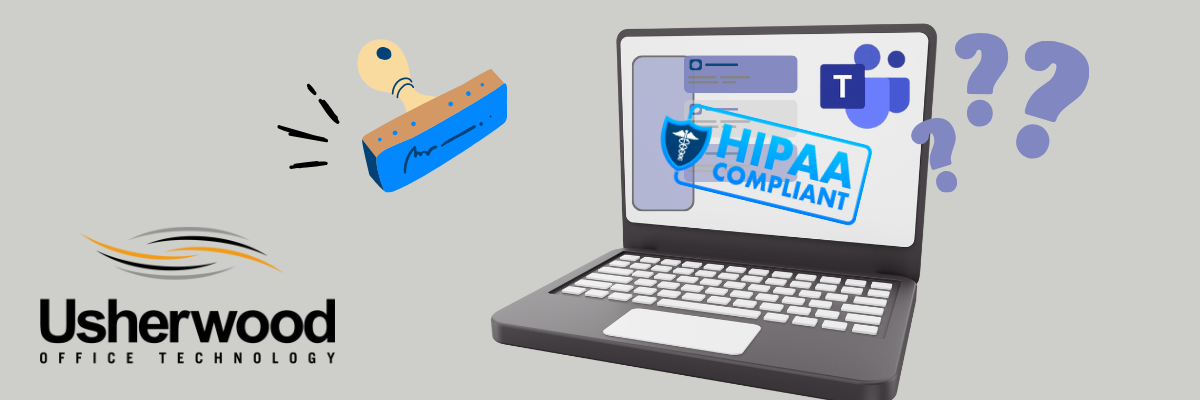By: Jada Sterling, Digital Content Manager on February 8th, 2024
Is Microsoft Teams HIPAA Compliant?
Many healthcare providers have pivoted after the COVID-19 pandemic to offer telehealth services. This creates a unique challenge for healthcare cybersecurity compliance outlined by HIPAA. This is because telehealth communications platforms will likely need to store and secure protected health information (PHI).
As you look for the best HIPAA-compliant telehealth platform for your needs, you may wonder if Microsoft Teams is compliant. This popular cloud-based platform offers video conferencing, private SMS chats, channels for employee communication, file storage, and many other collaboration tools.
The issue of data protection may be an obstacle, so here’s an overview of the platform’s potential for HIPAA compliance.
What Are the Requisites for a Service to be HIPAA Compliant?
The truth of the matter is that no software is inherently HIPAA compliant. This is because how you use the software can make or break your data protection strategy.
Generally, the unified communications solution you choose should have data encryption, effective access control settings, and strict data governance features to protect sensitive information.
Is Microsoft Teams HIPAA Compliant for Telehealth?
Teams cannot adhere to HIPAA standards without your active role in security and compliance. So, you’ll need to take steps to configure settings and use tools within Microsoft Teams to make it compliant. In this way, compliance is possible, but only through the proper use of Teams security features.
Protected Health Information (PHI) Encryption
Protected health data needs to be encrypted both in transit and at rest. This means it should be protected when sending it to another person as well as when it’s stored. In tandem with other Microsoft Cloud security features, Teams can be a very secure platform to store, manage, and protect PHI.
Secure Telehealth Meetings
Telehealth relies upon effective technology to connect providers with patients securely. Cloud videoconferencing software used by caregivers and patients should have:
- Crisp video and audio for accessibility
- Secure connections free from the threat of unauthorized meeting access
- Easy-to-use meeting settings
Teams provides accessibility for your patients, optimizes communication, and enhances patient care. It has security controls for meetings, but the care you take to protect patient data is the most important part of telehealth compliance.
In this way, it’s the responsibility of the covered entity to manage security rules and meeting settings properly to ensure compliance.
Data Loss Prevention Safeguards
For some security features in Microsoft Teams, you will need to purchase additional licensing for the added protection. It’s wise to explore these add-ons, such as Microsoft Purview. This allows you to prevent users from sharing protected information in inappropriate channels within Teams.
For example, say a staff member tried to send a document containing sensitive information to a guest user outside of your organization. With the right configuration and data labeling, you can set Teams to delete the message as it is set to prevent exposure.
How To Use Teams in Accordance With HIPAA
As mentioned before, Teams is only as compliant as you make it. Microsoft provides many resources for healthcare organizations about how to use it with HIPAA, such as whitepapers and FAQ pages. Here are a few simple Microsoft Teams best practices to get you started with making Teams HIPAA-compliant for your healthcare business.
1. Implement Access Controls
The HIPAA Privacy Rule outlines limitations and disclosures of PHI to only the “minimum necessary” parties. This means that PHI is to be regarded strictly on a need-to-know basis. Because of this, you’ll need to implement user access controls and determine a “role-based access” framework.
One way to do this in Teams is to use data labels. These will help prevent users from accessing files by searching keyword prompts if records are labeled with a certain sensitivity level. Learn more about sensitivity labels and how to configure them within Teams via Microsoft’s resource section here.
2. Multifactor Authentication for Users
Like most services, Teams allows you to configure multifactor authentication for users. MFA is a cybersecurity best practice since it requires two isolated forms of verification for users to access data and tools. This will drastically reduce the risk of unauthorized access from cyber criminals or other threat actors.
Often, cybercriminals will steal login credentials to use or sell on the dark web. If your organization uses MFA, it can mitigate the risk of hackers accessing your system with any leaked passwords. Keeping them out of your Teams can in turn protect sensitive data stored there.
3. Audit Logs
Another aspect of using Teams features to their fullest potential is recoding activities via Microsoft Purview’s audit log. This is a setting that tracks changes you make to administrative controls and other activities including:
- Teams group creation or deletion
- Communications compliance/policy updates
- Content exploration (i.e. see prompts from user searches within Microsoft Copilot and documents accessed from it)
- Directory and domain-related activities (i.e. adding delegated administrators or adding/removing a domain to an organization)
The audit log allows you to trace these activities in great detail, which can help you customize user access to PHI. This makes it a useful tool in your organization’s compliance since it allows you to fully oversee your access control management strategy.
4. Signing a Business Associate Agreement
As a part of your licensing agreements with Microsoft, you will automatically agree to a HIPAA Business Association Agreement (BAA). This applies to Microsoft's healthcare industry-specific licenses that facilitate compliance via added security measures.
According to Microsoft, the BAA it offers serves as “contractual assurances about data safeguarding, data access, and reporting in accordance with HIPAA and the Health Information Technology for Economic and Clinical Health (HITECH) Act.”
5. Training Employees on Proper Use
The biggest security risk to your data security is human error. Data exposure can happen quickly via simple mistakes. This is why training your team members on proper sensitive data management is crucial. Ensure your team is familiar with data handling practices and how to securely use Teams.
You can greatly reduce the risk of data loss by keeping your staff informed and up-to-date on the latest configurations of your HIPAA-compliant software.
How to Implement a HIPAA-compliant Communications Strategy
Once you’ve outlined what tools you’ll need to deliver HIPAA-compliant telehealth and communications, it’s important to stick the landing with effective implementation. Before introducing a new communications platform, there are several factors to consider to get the most out of your budget.
With all the different licensing and advanced features offered by Microsoft, it’s wise to partner with an experienced managed communications provider familiar with the service. To get started, click the button below to speak to a managed communications expert about your business.
Read On

Google Meet vs Microsoft Teams
Google and Microsoft are leading tech brands in the market. If you’re between the two for your...

Sen. Schumer Calls for Relief After Major Healthcare Cyber Attack
New York Senator Chuck Schumer recently sent a letter to the Centers for Medicare & Medicaid...

The Ultimate Guide to Data Security in Healthcare
Healthcare is an industry often plagued by cyber threats since hackers know the sensitivity of...




